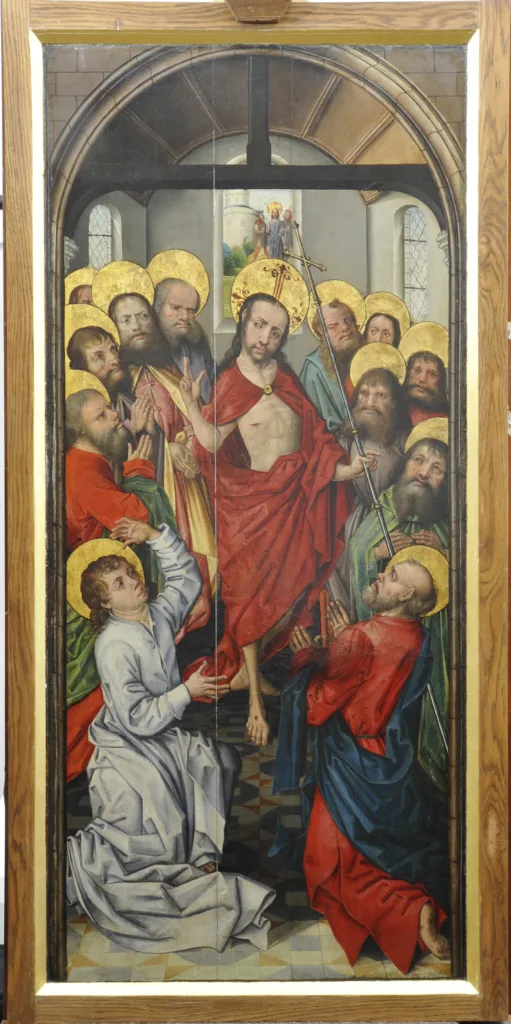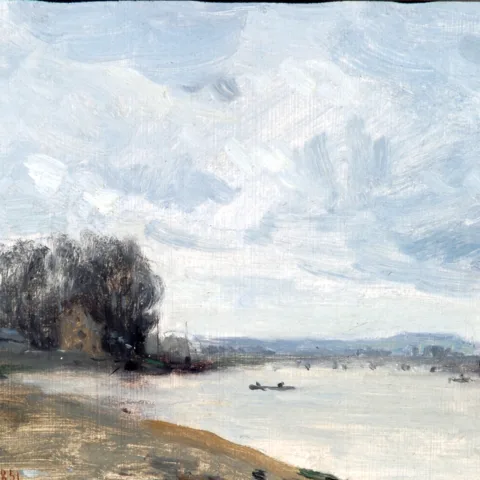The Bowes Museum Blog

Investigating A Masterpiece


Figure 1: Image of the 15th century altarpiece of ‘The Passion, Death & Resurrection of Christ’, with the panel paintings by The Master of the View of St Gudule and the wooden carvings by the Brussels Guild of Sculptures.
For my third post I want to tell you about the start of our work on the crowdfunded project to conserve the 6 quite exquisite double sided panels of a 15th century altar piece by the Master of the View of St Gudule (see previous posts Tagged ‘Altarpiece’ for further details). Our work up until this point has focused on undertaking the process of examining and documenting the current condition and structure of each panel, in order to produce an accurate condition report. These reports form the basis of knowledge onto which a tailored treatment plan will be moulded, which will endeavour to ensure the panels continued safe existence into the future, whilst not unduly interfering with, or tainting its artistic or historic legacy.
To enable this process to begin, and for the acquisition of the detailed information needed for the condition report, we employ a number of different diagnostic tools and examination techniques, which I will now try and roughly outline for you (please bear with me, it is interesting, I promise).
The process begins with photographing each panel in the studio, firstly under ‘normal’ lighting (bright studio lights), then using ‘raking light’ (where the light source is placed at an oblique angle to the surface of the painting), and if warranted ‘transmitted light’ (where the light source is positioned behind the painting).
Here are examples of each type of photograph in action, showing how these different lighting techniques can each be useful in highlighting different problems.
Example 1:
The raking light photograph shows the presence of areas of loose flaking paint.
Example 2:
The transmitted light photograph helps to reveal the extent of the break in the join of the panel.
Photographs in ultraviolet light and infrared are also essential aids and respectively can potentially yield such information as the presence of unoriginal paint material, to the outline of the original underdrawing, but as they have not been taken yet for this project (due to a soon to be resolved technical issue), I will not go into further detail here.
The next stage is where the majority of the hands on detective work takes place, as the panels are each carefully and closely examined lying face up on a secure mortuary table (sorry just trying to paint a memorable scene). Every square centimetre of the painting is studied using low level magnification (head magnifiers – not Homes-esque magnifying glasses sadly) and LED torches (raking light), for any anomalies on or in the surface of the painting (losses, cracking, flaking paint, foreign material etc), a UV torch is also used, which in this case helped to indicate both the presence of an aged varnish layer as well as areas of unoriginal paint material. The last tool in our armoury to be deployed is the binocular microscope (X 60 magnification), which we keep in reserve for the close up examination of areas of structural or conditional interest, which for this project included the identification of suspected areas of non-original paint material through the study of individual brush strokes.
Each piece of information (evidence) from these various sources is slowly gathered together, and enables us to quite literally build up an accurate picture of the condition and structure of the painting (as can be seen below). The form of this overall ‘picture’ will then dictate what course of action that will be taken in terms of treatment.
Example 3:
Showing a photograph of St Antony in ‘normal’ light on the left, and then the same photograph of St Antony on the right with the addition of the different information gathered through the condition reporting process.

Figure 8: Image of ‘Saint Antony taken in normal light with the gathered conditional information added. Black outline = Flaking paint, Red outline = unoriginal paint (retouching), Green outline = Loss, Blue outline = Areas of previous selective cleaning, aged varnish removed.
Stay posted for future updates on the treatment of the 6 double sided 15th century altarpiece panels by the Master of the View of Saint Gudule.
By Paul Turner, Paintings Conservation Intern













